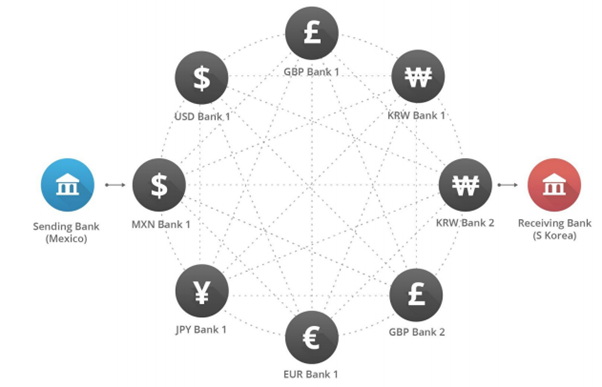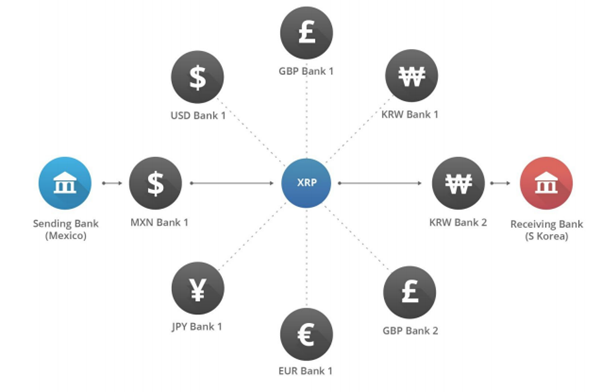XRP’s Role on Ripple and in the Internet of Value
November 2015
Why the World Needs Ripple
Payments don’t meet the expectations of 21st century consumers or the needs of an
inclusive global economy. They are the cornerstone of global economic activity. Yet, as
the modes of payment grow more inventive and more convenient (mobile, social,
machine to machine), the actual settlement of payments is mired in decades old
technology.
Think about the last time you sent an i nternational payment , in particular. Did it take days?
Did you understand the fees and foreign exchange rate? Was it expensive? Were you
worried it wouldn’t get there? Domestic payments encounter friction too, but
cross-border payments are the slowest and most expensive. The reason they’re so slow
and expensive is they’re beholden to antiquated and inefficient infrastructure, built
country by country, before the dawn of the Internet.
Today, payment networks are siloed. Correspondent banking connects networks through
a series of intermediary banks and central counterparties. Each intermediary adds cost,
obstructs visibility, and creates a potential point of delay or failure.

Correspondent banking is capital intensive for liquidity providers. It requires they have
global operations and hold liquidity in local currencies all over the world. Thus, fewer
than ten banks in the world provide liquidity for global payments, so FX rates aren’t
competitive. Then, each intermediary marks up the rate, so smaller banks and end
customers see worse rates.

The numbers are telling. On average, international payments take 2+ days to settle, 4
percent fail1, 12 percent result in errors2, and they create total costs of $1.6 trillion3
annually.
We believe payments, and more broadly value, should move like information moves on
the web today - globally, securely, instantly, freely. By design, this Internet of Value will be
built on open web standards (e.g. I nterledger Protocol) and involve the participation of
existing payment service providers (e.g. financial institutions, payment networks) and
new types of providers (e.g. distributed financial technology companies). These
standards and new distributed financial technologies will connect the world’s financial
systems - both new and old - so value will move across systems and borders with the
least friction possible, and so all participants can benefit from the economies of liquidity
at scale.
By modernizing the underpinnings of payments infrastructure with IP-based technology,
the Internet of Value will initially allow individuals and businesses to enjoy instant, lower
cost, secure cross-border payments, and payment service providers to enjoy greater
business opportunities. In the future, it will create access for the financially underserved
to affordable payment services, for individuals to tap into new sources of value, for
businesses to expand reach, for technology companies to innovate in presently
unimaginable ways, and for economies to grow exponentially.
1 Robinson, Edward. "Former Goldman Exec Wants to Upend the Way the World Moves Money." Bloomberg : n. pag. Web. 7
Apr. 2015.
2 "Does Valid Bank Account Data Matter?" Experian : 8. Web. 2014.
3 World Trade Organization, Federal Reserve Financial Services, Institute of International Finance, Ripple Analysis
How Ripple Can Spark the Internet of Value
To map how we get there, let’s look at how all successful Internet technologies, including
the Internet itself, took off. They built network effects, matching supply with demand. As
these marketplaces flourished, efficiencies increased, participants realized greater
returns, and experiences improved exponentially.
Every marketplace starts with a chicken-and-the-egg problem: the supply side won’t
come to the table or make significant change unless there’s demand. And, demand is
challenging to prove without real supply. The classic example is the telephone network -
a brilliant invention but pretty useless for the first phone owner, who had no one to talk
to.
How, then, does Ripple build network effects?
Let’s start by identifying the actors. When we evaluate how all payments work, they
ultimately require account-to-account settlement either within a bank or between banks.
Even if you use Venmo or Paypal to pay a friend or a merchant, you still ultimately rely on
banks to custody and move your money. Cross-currency payments require liquidity
provision, which top global banks provide today as discussed earlier. Then, in Ripple’s
marketplace, banks and third-party liquidity providers s upply payment services and
liquidity for individual and business customers, who have demand for payments.
What’s in it for banks?
Ripple offers, for the first time in history, the ability to transact directly, instantly and with
end-to-end visibility and certainty of settlement. These unique characteristics present
new business opportunities for banks to compete with upstarts.
For large, global banks, Ripple reduces risks and thus compresses operational costs4,
furnishing them the opportunity to leverage their existing FX operations to build
profitable low-value payment services, like remittances and disbursements, and increase
their wallet share.
For small to mid-sized banks, Ripple offers an entirely new, unbundled model for
cross-border payments. Ripple enables them to directly transact with other banks
globally, sourcing liquidity from an open marketplace of third parties and allowing them
to introduce competitive cross-border payment services to attract new customers.
4 Operational costs include treasury operations, processing and liquidity costs.
What’s in it for third-party liquidity providers?
Through its novel design, Ripple facilitates competitive bidding on liquidity provisioning.
Third-party market makers, such as hedge funds, enjoy access to an entirely new and
ever-growing opportunity to provide liquidity for global payments, profiting from
spreads.
What’s in it for individual and business customers?
Banks that adopt Ripple can offer their consumer and business customers improved
payment services that are faster, less expensive, and offer greater visibility into delivery
status.
Ripple leads the market today in delivering on the interbank cross-border payment use
case. Banks now adopting Ripple benefit from new efficiencies in payments processing.
To date, Ripple is the only provider of enterprise-grade solutions, tried and tested by
more than a dozen banks using real money. Ripple solutions are based on Ripple’s core
technology, which accommodates instant cross-currency settlement and is scaling to
process limitless throughput of transactions.
Out of the gate, Ripple injects an outmoded system with new processing efficiency,
creating immediate return on investment for first adopters. As a marketplace, benefits
grow exponentially as more participants join and as it becomes a thick market. Ripple’s
native digital asset, XRP, can help expedite market thickness on Ripple.
From a Spark to a Wildfire
As liquidity on Ripple grows, so do the number of currencies and counterparties. In this
state, there will be many options to execute a currency trade. Liquidity providers need to
open and maintain accounts with each institution for each currency - a capital- and timeintensive
endeavor that spreads liquidity thin. It’s more challenging for the marketplace
to offer tight spreads with thin liquidity. In the example below with eight banks, a liquidity
provider would need to quote up to 28 currency pairs to participate in all order books.

Further, some options will involve many trading parties, who each layer costs to the
transaction, especially long-tail payments in exotic corridors. These complex paths make
competitive pricing challenging for long-tail payments.

Ripple is uniquely positioned to solve these problems as a multi-currency distributed
financial technology with a native digital asset, XRP, that directly bridges any two
currencies. By using XRP, liquidity providers reduce operational costs and have the
opportunity to specialize in certain currency corridors. Similar to USD, XRP allows market
makers to concentrate their liquidity around fewer pairs, creating order book thickness
and competitive FX rates. Unlike USD, trading through XRP does not require bank
accounts, service fees, counterparty risk, or additional operational costs. In this example,
market makers collectively only have to quote eight currency pairs (versus up to 28 in the
previous example) to reach the same number of destination currencies.

Using XRP as a bridge asset, complex cross-currency payments can be executed without
additional trading parties, translating to lower costs for even exotic corridors.

XRP is an attractive asset for liquidity providers to create liquidity between any two
currencies at incremental cost. To offset the risk of bridging currencies with a new asset
like XRP, we plan to subsidize its use in the early days. With XRP, market makers
systemwide can offer tighter spreads than traditional currency markets, fast-tracking
Ripple’s path to market thickness.
This offer is immediately compelling to small to mid-sized banks, which today rely on
large correspondents to provide liquidity for cross-border payments. By sourcing liquidity
from third-parties who make markets through XRP, smaller banks can offer more
competitively priced payment services to attract new customers.
Initially, large banks will continue to source liquidity from their own FX operations and
improve their processing efficiency using Ripple. However, as Ripple’s currency market
grows, large banks will see benefit to posting and sourcing liquidity to and from it as well.
Conclusion
The advent of distributed financial technology has set the unfolding of the Internet of
Value in motion. As our CEO Chris Larsen says: “The genie is out of the bottle.” As with
any marketplace, the Internet of Value needs to first solve the chicken-and-the-egg
problem: attract both supply and demand.
As a uniquely positioned distributed financial technology, Ripple plays a key role initiating
network effects in the Internet of Value. In a marketplace context, Ripple affords liquidity
suppliers (banks and third-party market makers) and liquidity takers (people and
businesses who need payments) step-function improvement over how cross-border
payments work today:
- Large, global banks lower operational costs to increase wallet share.
- Small to mid-sized banks gain direct access to competitive liquidity to
attract new customers.
- Third-party market makers compete to provide liquidity for global
payments.
- People and businesses enjoy faster, less expensive payment services with
new visibility into tracking and delivery status.
The introduction of third-party liquidity providers significantly transforms the face of
payments and accelerates the growth of Ripple’s marketplace. The more participants in
liquidity provisioning, the more competitive the marketplace. Competition encourages
broader adoption and participation - in sum, network effects.
As a digital asset, XRP is a useful trading instrument to reduce spreads and expedite
market thickness. To incentivize early participation of liquidity providers, Ripple will
implement programmatic distribution of XRP to those who use it to offer better spreads
on currency trades and payments.
With clear and validated benefits to bring both supply and demand actors to the table,
Ripple’s marketplace is already developing: large banks are joining to improve processing
efficiency, and small to mid-sized banks are joining to leverage third-party liquidity
providers for cross-border payment services. As these network effects build, Ripple and
XRP will play a central role in driving development of the Internet of Value.















